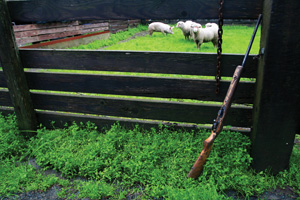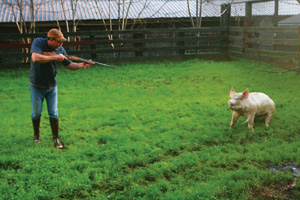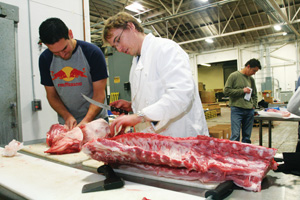Features & Columns
Conscious Carnivores
 Photograph by Felipe Buitrago
Photograph by Felipe Buitrago
BY THE TIME Peter Licht pulled into Devil's Gulch Ranch in west Marin County to pick up his pig, four lambs had already been slaughtered and lay lined up on the grass. Mobile butcher John Taylor made quick work of them, skinning, gutting and cleaning each animal with small sharp knives in about 15 minutes. As a hydraulic winch hoisted each for processing, steam rose from the still warm carcasses as they swayed in the early morning sun.
When Taylor began to walk toward Licht's 225-pound sow, the animal scampered about the grassy corral with four other lambs. A red stripe had been painted on each animal's head to mark it for slaughter. Taylor, a man with a bushy mustache wearing rubber boots, followed the pig with a worn .22 caliber rifle hanging casually from his right hand. Then the animal stopped its evasive maneuvers and squared around to face the man with the gun as if to say, "OK. I know why you're here. Let's get on with it."
Taylor brought the rifle to his eye and with a crack hardly louder than a cap gun shot the pig in the middle of its forehead, killing it instantly. He got to work again, hoisting the pig from an incision he cut under its jaw. In just a few minutes, he transformed the animal from a living creature into two split halves of well-marbled pork.
This pig had led a pretty good life. It got to roam the ranch's green hillsides and enjoy a fat-producing diet of organic bread and milk. Hers was a world away from the caged misery of most commercial pigs raised in the United States.
As Licht watched Taylor work, he was thinking sausage. And pulled pork sandwiches. And prosciutto. Taylor loaded the hulking sides of pork into the back of Licht's red Subaru. Licht paid Taylor for his work. He also paid farmer Mark Pasternak, who raised the animal.
The pig sold for $2 a pound for what's called "live weight"—$450.
In addition to a roll of bills, Licht gave each man a 12-pack of beer. Licht, a San Jose resident with an easy laugh, is the brewmaster for Mountain View Tied House Cafe and Brewery. It's good to do business with a brewer.
 THAT'S ALL FOLKS: Mobile butcher John Taylor sells his services to family ranchers, and a new breed of shoppers who want to know where their meat comes from.
THAT'S ALL FOLKS: Mobile butcher John Taylor sells his services to family ranchers, and a new breed of shoppers who want to know where their meat comes from.
Cutting Out the Middleman
Licht is a man who likes to look his meat in the eye. He wants to know where it came from and how it was raised. While most meat eaters choose to ignore the reality of what they eat, Licht and a small but passionate number of like-minded folks in Silicon Valley choose to cut out the middleman and source their meat themselves.
They buy from local ranches far removed from crowded and toxic factory farms where the vast majority of commercial animals are raised. Sometimes, they come to watch the animals slaughtered. Later, they hold butchering parties to divvy up the meat and throw some on the grill.
All the blood and guts can be gruesome, but these people say that averting their eyes from meat production allows the environmental and social injustices of industrial-raised meat to grind on away from public view.
Most of us are cowards, silently eating our burgers and bacon and pretending everything is OK. But for those who choose to investigate the source of their food, the knowledge can be life changing.
"Some people decide to become vegetarians and some decide to eat better meat," says Licht.
Licht is firmly in the latter camp. He started the South Bay chapter of the Bay Area Meat CSA a year ago to help feed his charcuterie habit and to assuage his distaste for industrial-grade commodity meat. The organization started as a Slow Food project in Berkeley and has grown to 30 chapters across the Bay Area and beyond. There are even chapters forming in Southern California and Minneapolis–St. Paul, Minn.
CSA—community-supported agriculture—is an arrangement in which supporters pay a farm a lump sum each season for a "share" of the farm's produce each week. Technically, the Bay Area Meat CSA is not a true CSA, because members aren't buying into local ranches for regular shipments of meat, but the support for local food is in line with the CSA ethos.
The South Bay chapter of the meat club is one of the largest and reportedly buys the greatest volume of meat. The 84-member group of carnivores is essentially a meat co-op. Members pool their money to buy cows, pigs, goats and lamb. So far they've purchased four cows, eight pigs and several goats and lambs, all from Bay Area ranches.
In addition to being a professional brewer, Licht is a skilled home butcher with a fondness for making hams, salami, prosciutto and other cured meat. He makes his own hot dogs, too.
"I don't buy meat at the supermarket anymore," he says. "I don't need to. You know a lot more about meat if you do it this way."
 HAND'S ON: Marcus Torres (left) attended a recent meeting of the South Bay Meat CSA, hoping to learn how to butcher from Peter Licht (right).
HAND'S ON: Marcus Torres (left) attended a recent meeting of the South Bay Meat CSA, hoping to learn how to butcher from Peter Licht (right).
Meat Club
The day after the slaughter, Licht and two members of the Peninsula Meat CSA along with a newcomer to the South Bay chapter met at the Tied House's production brewery near Spartan Stadium to parcel out the pig. The Peninsula club is just getting off the ground and didn't have an experienced butcher like Licht, and the women who showed up wanted to learn how—and they wanted some pork.
Dressed in kitchen whites, Licht muscled half of the pig onto a stainless steel table and began butchering the animal.
"Usually people want as much bacon as they can get," he said as the meat club members vied for different cuts.
The women cooed at the sight of the triangular slab of pork belly, but they had their eyes on other cuts, too: ribs, shoulder, chops, kidneys and legs.
"You don't get the lard," Milbrae resident Liz Alcamo told another member with good-natured assertiveness. "I'm a pie girl." Leaf lard pulled from the kidneys is sought after by home bakers for making supremely light and flaky pie crust. It's what the world used instead of butter before the advent of Crisco. And it can't be found at Safeway, or Whole Foods for that matter. The only way to find it is to go the source: a whole pig.
As Licht sliced, hacked and sawed cuts of meat with his knives and his Butcher Boy band saw, the women wrapped the packages and labeled them with Sharpies. All of them said they joined the meat club because they wanted an alternative to commercially available meat.
"The environmental impacts of industrially farmed meat are unsavory to me," said Palo Alto's Kathy Mach, who had come down to the butchering party with her friend Alcamo.
She cited the creation of vast manure lagoons and the use of antibiotics in industrial-meat production as some of her reasons for seeking out alternative sources. Buying meat this way costs more, but she says she'd rather bear that cost than pass the price of so-called cheap meat onto the environment.
The negative effects of cheap meat are staggering. According to a study published by the Pew Commission in 2008, intensive livestock production creates a number of problems.
"These include contributing to the increase in the pool of antibiotic-resistant bacteria; air quality problems; the contamination of rivers, streams, and coastal waters with concentrated animal waste; animal welfare problems; and significant shifts in the social structure and economy of many farming regions throughout the country."
On top of that, greenhouse gas emissions from all livestock operations account for 18 percent of all human-caused greenhouse gas emissions, exceeding the emissions caused from the transportation sector.
The cheaper meat is at the grocery store, the more costly it is for the environment, public health, rural communities and animal welfare. Savings at the supermarket for meat that costs 99 cents a pound are only possible because the industrial meat industry is permitted to push the true costs off on everyone else. We all pay in the end.
Los Gatos resident Reuel Warkov didn't make it out to the pig party, but the South Bay Meat CSA member has been part of two other meat buys—a pig and a goat. While not all the meat he buys is "good meat," he seeks out righteous meat whenever his wallet allows.
"I read Michael Pollan, and I've never been the same since," he said, referring to the food activist and author of The Omnivore's Dilemma. Warkov says that Pollan's critique of petroleum-dependent, planet-fouling agricultural practices that dominate the industry "changed the way I look at the world."
Most livestock are fed grain, feed that requires oil-based fertilizers and the diversion of land and water from the production of human food. Cattle are ruminants and are evolved to eat grass, not corn and soybeans. Eating grain makes them fat, but it also makes them sick. That's why conventionally raised livestock must be fed a diet of antibiotics. A corn-fed cow is a sick cow. This chemical- and petroleum-intensive method of animal production gets worse when animals are transported often long distances to large, centralized slaughterhouses and then trucked around the country for distribution.
In The Omnivore's Dilemma, Pollan argues that we need a "re-solarization" of the food chain by taking the petroleum out of meat production and relying on the sun to grow grass. He calls for a shift toward locally raised, slaughtered and distributed meat (and produce) to further reduce our reliance on fossil fuels.
From an environmental perspective and a quality perspective, buying locally raised meat just makes so much more sense. But common sense isn't a feature of U.S. agricultural policy. Federal subsidies have kept the price of cattle feed well below the cost of letting cows graze on grass. Rising petroleum costs (or declining oil reserves) may change that.
While Warkov is guided by environmental principles and his budget as he sources his meat, he's drawn to the social aspects of group meat-purchases, too. The butchering parties sometimes turn into real parties with attendees breaking out bottles of home-brewed beer—and of course lots of meat.
"It's great. We have so much fun."
To keep the meat party going, Warkov created an invite-only, online social network called Meat Tree where participants trade photos, articles and discussion about meaty matters large and small.
While these Silicon Valley meat lovers get access to premium-quality protein, the group and other individuals across the Bay Area are helping keep the local food economy alive through their support of humanely and sustainably raised livestock, an industry that depends on chefs and individual customers to keep it economically viable.
Roots of a Revolution
In addition to the pork that Devil's Gulch Ranch produces, Pasternak also raises rabbits and lambs. While 60 percent to 70 percent of the meat goes to local restaurant customers like Manresa, Sent Sovi and Santa Cruz's Gabriella Café, it's processed at U.S. Department of Agriculture–approved slaughterhouses.
But Pasternak deals directly with the public by selling live animals like Licht's pig. Legally he can't sell slaughtered meat to the public from his ranch, but live animals are different. Typically, his customers contract a mobile processor like John Taylor to slaughter the animal and either have it processed by a local butcher or do it themselves.
In the three decades he's been in the livestock business, direct sales of live animals have always part of what he does, but Pasternak says that interest is growing.
"There's always been a contingent of people who realize it's better to buy food closer to the source rather than in a package at the store," Pasternak says. "There's certainly more interest in it now. ... I love it. I'm energized by the exchange of ideas."
Joe Morris, a cattle rancher in San Juan Bautista who produces beef fed on native grass, sees his relationship with the public as central to everything he does.
"Through the food we produce we can connect people with the life on the land," he says. "We see that as a relationship that has been stretched if not broken in the United States. We want more people to collaborate with us."
His number of collaborators is growing. "It's becoming more popular. Every year we're grown 20 to 30 percent."
Morris, who has been in business for 17 years, doesn't sell his beef in stores but directly to the public across the Bay Area through his own CSA program.
What sets Morris apart from most cattle producers and even many grass-fed beef producers is his holistic approach. The way he sees it, he's not just raising cattle but native grasses, soil and microscopic organisms in the soil as well. The health of each is linked to the whole.
As a result of this closed-loop system, he says his 200-acre ranch and the other grasslands he leases benefit from more biodiversity. The well-developed, deep-rooted soil also acts a sink for carbon and water.
That's a far cry from the environmental disaster of corn-fed, feed-lot cattle injected with antibiotics to combat the ill effects of their unnatural diet and unhealthy conditions.
"Most ranchers are still relying on old ways of doing things in a new world, and it's not working so well," he says. But he's encouraged by the change of consciousness he's seeing in the public.
"I think there's a building momentum toward change. We're learning that there are better ways to do things."
Enlightened carnivores like Licht are doing their part. He realizes that buying a side of beef may not be as convenient as a trip to Costco, but for him it's worth it if it means rolling back the ill effects of industrial meat and getting better tasting food along the way.
"It's not hard to flip it back," he says, "if you're willing to make a little effort."


